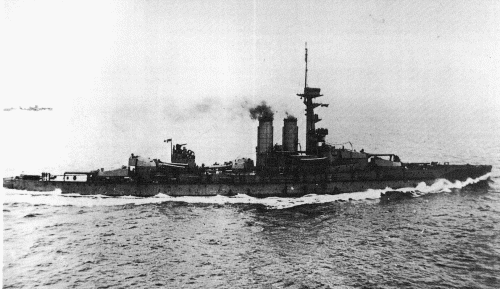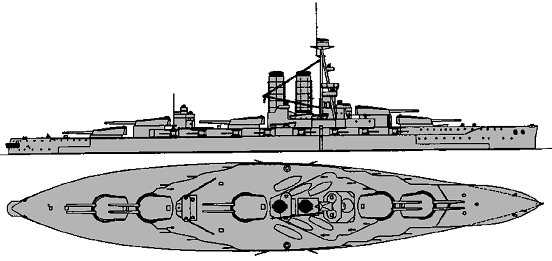
NAVYPEDIA
 Support the project with paypal
Support the project with paypal
Photo

Erin 1915
Ships
| Name | No | Yard No | Builder | Laid down | Launched | Comp | Fate |
|---|---|---|---|---|---|---|---|
| Erin (ex-Reshadieh) | 56, 61, 76 | 425 | Vickers, Barrow | 1.8.1911 | 3.9.1913 | 8/1914 | sold for BU 12.1922 |
Technical data
| Displacement normal, t | 22780 |
|---|---|
| Displacement full, t | 25250 |
| Length, m | 170.5 |
| Breadth, m | 27.9 |
| Draught, m | 8.70 mean |
| No of shafts | 4 |
| Machinery | 4 Parsons steam turbines, 15 Babcock & Wilcox boilers |
| Power, h. p. | 26500 |
| Max speed, kts | 21 |
| Fuel, t | 2120 coal + 710 oil |
| Endurance, nm(kts) | 5300(10) |
| Armour, mm | belt: 305 - 102, bulkheads: 203 - 102, turrets: 279 (faces), barbettes: 254 - 76, deck: 76 - 39, CT: 305 |
| Armament | 5 x 2 - 343/45 BL Mk VI, 16 x 1 - 152/50 BL Mk XVI, 2 x 1 - 76/45 20cwt QF Mk I, 6 x 1 - 57/50 6pdr Vickers Mk II, 4 - 533 TT (beam) |
| Complement | 1070 |
Standard scale images

Erin 1915
Graphics
Project history
Ship was constructed for Turkey but requisitioned when war started. Reshadieh (ex-Reshad V) was one of a pair of ships ordered by Turkey in 1911, but Reshad-i-Hammiss was cancelled in 1912 and replaced by order purchased from Brazil. The design made by Vickers was based on King George V with some features of Iron Duke. The hull was shorter and beamier, and the 'Q' turret was a deck higher, which was made for better shooting in a seaway, and the battery was marginally better arranged than in British ships. The short hull was made for a tight turning circle. Although on paper nearly as good as Iron Duke on 2000t less, Erin displayed the usual trade-off of qualities in private shipyard designs. The armour belt was 76mm thinner and shallower than on King George V, with 1130t less coal and less endurance, but this was adequate for North Sea operations, so did not reduce effectiveness.
Protection
Main armoured belt was extended between barbettes 'A' and 'Y' and 99.6m long. Between its lower edge (1.12m below wl at normal load) and middle deck its thickness was 305mm and between middle and main decks it was reduced to 229mm. At fore end forward from centre of barbette 'A' thickness of main belt was 152mm at 9.2m part and 102mm at later 4.6m, additional 26.7m of main belt aft from centre of barbette 'Y' also had 152mm and 102mm thickness. Upper belt was extended between barbettes 'A' and 'Y' and main and upper decks and had 203mm thickness, it was closed by 203mm bulkheads, depth of both belts was 6.9m. Main belt was closed abreast end barbettes by fore and aft bulkheads, their thickness was 203mm between upper and main decks and 127mm between main and lower decks. Ends of 102mm belts were closed by 102mm bulkheads.
343mm turrets had 279mm faces and sides, 203mm rears, 76mm floors and 102mm(rear part)-76mm(fore part) roofs. Barbette of 'A' turret had 254mm protection above and 127mm below main deck at fore part and sides and 229mm(above forecastle deck)-127mm(between forecastle and upper decks)-76mm(below upper deck) aft part. Barbette of 'B' turret had 229mm(fore)-254mm(sides and aft) armour over forecastle deck, 127mm between forecastle and upper decks and 76mm below upper deck. Barbette of 'Q' turret had 254mm armour above forecastle deck, 127mm between forecastle and upper decks and 76mm below upper deck. Barbette 'X' had 254mm(fore) protection above forecastle deck, 254mm(sides)-229mm(aft)-127mm(fore) between forecastle and upper decks and 76mm below upper deck. Barbette 'Y' was protected by 229mm(fore) armour above upper deck, 254mm(aft and sides)-127mm(fore) between upper and main decks and 127mm(aft and sides)-76mm(fore) below main deck. CT had 305mm sides and 102mm roof and deck, communication pipe had 152mm protection.
Upper deck had 38mm protection under 152mm battery, main deck between end barbettes had 38mm armour. Middle deck had 25mm thickness at flat and slopes between end barbettes and was connected by slopes with lower edge of main belt. Funnels uptakes had 25mm armour. There was 38mm longitudinal torpedo bulkhead between end barbettes.
Modernizations
1918: + flying-off platforms on turrets "B" & "Q"
Naval service
Paid off 1919 and sold for BU in 1922 to comply with Washington Treaty.
Many thanks to Wolfgang Stöhr for additional information on this page.
 HOME
HOME FIGHTING SHIPS OF THE WORLD
FIGHTING SHIPS OF THE WORLD UNITED KINGDOM
UNITED KINGDOM ERIN battleship (1, 1914)
ERIN battleship (1, 1914)
